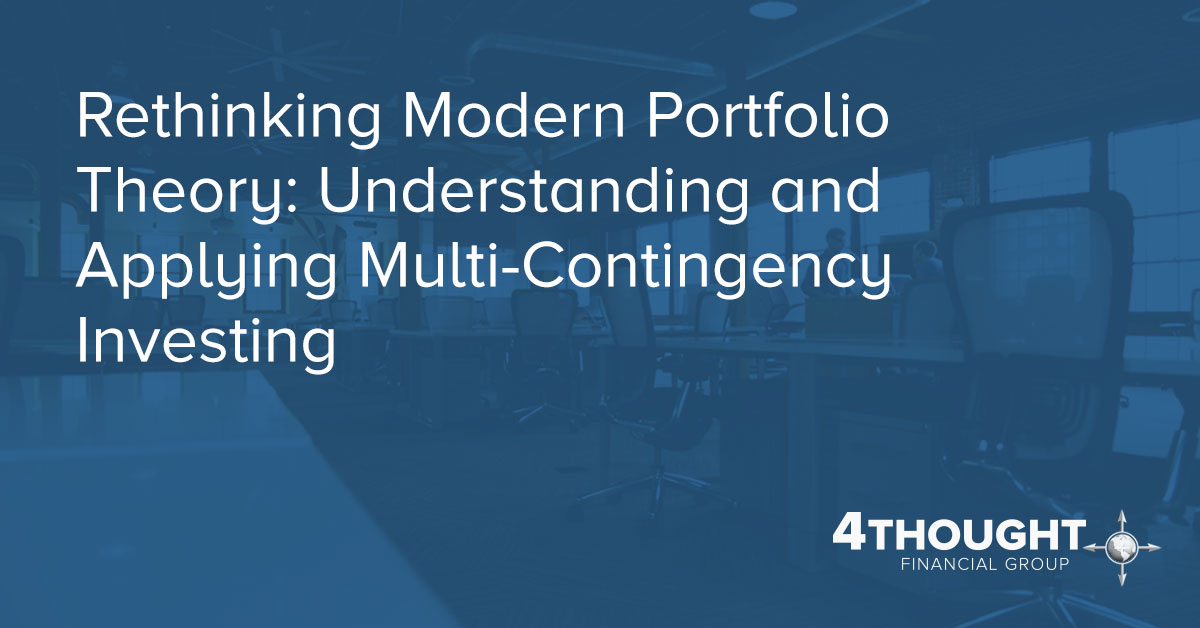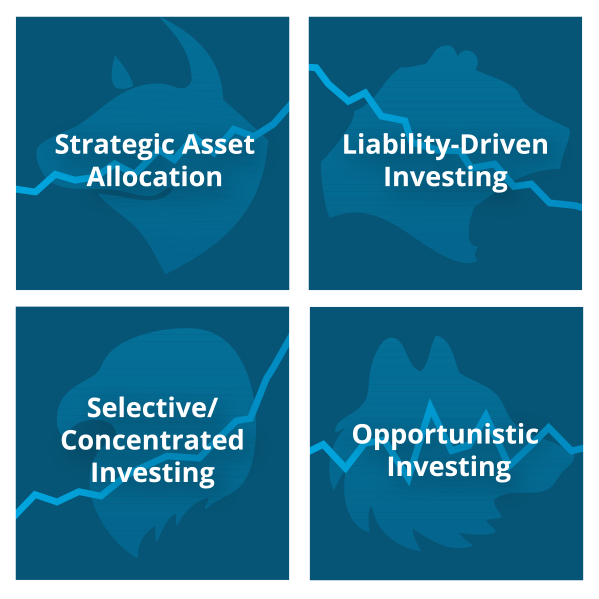
In our last two issues of the Compass & Crosshairs, we introduced the concept of multi-contingency investing and why the current financial/economic crisis has made this a new practice management imperative for financial planners, CPAs that provide financial planning services, and investment managers.
Pre-2009 single-philosophy investment managers had the luxury of believingin an unwavering and unchanging set of principles that could be applied to all client situations, whether they came from the Modern Portfolio Theory-based strategic school of thought, the tactical school, or an entirely different one. But a multi-philosophy manager must be able to “multi-think” from a variety of different ideological perspectives. This requires an investment planner or planning advisor that is highly technically skilled, familiar with multiple philosophical disciplines of investing, and is uniquely skilled in recognizing when and for whom to apply them. Although the difficulties of this are clear, if it can be applied with alacrity the benefits to investors will ultimately be significant, as discussed in the previous two issues of this series, Rethinking Modern Portfolio Theory.
In our last issue, we mentioned the following investment philosophies and sub-philosophies:
-
Direct Asset/Liability Matching
-
Pure Fixed Income / Capital Preservation
-
Traditional Institutional-Style Strategic Asset Allocation
-
Yield Target Distribution Portfolio Asset Allocation
-
Global Development Perspective Strategic Asset Allocation with Tactical Currency Hedging
-
Concentrated Thematic Buy and Hold
-
Short Term 100% Tactical/Opportunistic Management
We will now briefly explore the basic theory behind these methods, discussing when they should be applied and for whom they are appropriate.
Direct Asset/Liability Matching
Theoretical Tenets:
This philosophy is closely associated with comprehensive financial planning, but in its pure investable asset format is based on direct hedging or insuring. The idea behind it is that for a definitive investment objective in which parameters are known, one can use an appropriately structured tool to directly hedge the risk that an event will occur (usually at a nominal cost to do so). By using this methodology, one can mostly or completely eliminate the negative consequences associated with the risk.
For example, the creation of a non-diversified fixed income portfolio of inflation protected securities for a retirement real capital value preservation objective would be considered direct asset/liability matching if the objective of the client is simply to preserve assets for later consumer spending without erosion of purchasing power through inflation.
Case Profile (When and who to use it with):
This philosophy, although applied thoroughly in the practice of comprehensive financial planning for individuals is also commonly applied to institutional client investment objectives. It is optimally used for a client that has very well-defined investment objectives (“I want this account to be directly tied to inflation over a ten year time horizon for real return purposes, regardless of whether I lose nominal value in my account”), or that has significant concentrated risks (“I need to hedge against the risk of a decline in the price of soybeans for the next six months”), or well-defined liabilities (I have issued a note that has to be paid off in 8 years and the interest rate is tied to LIBOR).
In order for an asset/liability match to be effective as a stand-alone investment, ample assets to fund the asset/liability matching plan must be available – an important consideration for the individual investor. Again, most individual clients do not have all of their investment objectives focused in this category, and thus the methodology will not apply to all of their assets.
Pure Fixed Income/Capital Preservation
Theoretical Tenets:
During catastrophic market losses of the type experienced in client portfolios from 2007-2009, those who held individual fixed income issues to maturity were provided with the inherent issuer guarantee of maturity value and coupon payments (provided the issues were held to maturity), while those who used only actively traded bond funds and were exposed to the stock markets were subject to significant portfolio losses.
One should recognize that different investment vehicles may perform differently under certain market conditions, even when they provide exposure to the same asset class. Bonds are an excellent example of this. In the traditional bond arrangement, which features the purchase of individual fixed income securities held to maturity, the degree of risk related to interest rate fluctuation and bond market movement is minimized because an investor knows for certain the amount that he/she will invest, the coupon and yield amounts, and the amount of principal to be received if the asset is held to maturity. Issuer credit risk remains in that issuers can at any time default on payment of the debt.
Under another scenario, investors can gain exposure to bonds through mutual funds or ETFs. In this case, a portfolio manager may actively trade the bond portfolio in an effort to generate alpha. This approach generally maximizes diversification for investors with low levels of investable assets for a particular bond type, but leaves investors susceptible to fluctuations in interest rates and the prices of the securities if they are sold prior to maturity by the bond fund manager. For many fixed income investors, this was a significant problem during 2008, as the ability of managers to generate alpha in this market environment was generally almost nonexistent, with a few exceptions. However, such an approach allows investors with low levels of investable assets for a specific type of bond to access a numerically diversified portfolio for the bond component of an asset allocation.
Investors who are content with the returns associated with fixed income despite the erosion of those returns by inflation should pursue an individual-securities-based fixed-income-only portfolio. However, if they do not have a large portfolio to invest, they will not be able to achieve the diversification necessary to sufficiently reduce issuer credit risk. Optimality lies (when working with a large enough portfolio) in building the majority of the fixed income portion of a portfolio with individual issues, and building in the remainder of the low correlation fixed income types (such as international bonds, floating rate securities, government agencies, etc.) using mutual funds and ETFs. This results in a portfolio with a relatively predictable target risk/return, and diversification by number of securities as well as type of securities.
Case Profile (When and who to use it with):
This option is applicable to clients that need to preserve their nominal capital value but want a slightly above-money-market rate of return, and have no interest in participating in stock market upside or protecting their portfolio against inflation.
Many clients who have been witness to major drops in their investment portfolios during the severe market experiences since 2007 have come to the realization that they are far less risk tolerant than they had originally believed. For these clients, as well as those whose life circumstances may have changed as a result of the financial market crisis, it may become appropriate to reallocate portfolios on a much more conservative basis – using an ultra-conservative methodology such as fixed income only/ capital preservation.
For most investors with a long time horizon, this ultra- conservative investing philosophy is not appropriate on an analytical basis (as opposed to an emotional one), but for those clients who have a short investment time horizon or extremely low risk tolerance, it is necessary to provide appropriate options. A sub-option here involves the reinvestment of fixed income coupons in inflation hedges such as stocks, commodities, and TIPS in order to attempt to preserve some purchasing power in the long term.
Traditional Institutional-Style Strategic Asset Allocation
Theoretical Tenets:
Pure strategic asset allocation is that which is most closelyassociated with the origins of Modern Portfolio Theory, while what has become Traditional Institutional-style strategic asset allocation is the most prevalent historical outgrowth of MPT.
This systematic method of risk control is meant to eliminate human error from portfolio management.
The MPT methodology involves identifying optimal combinations of assets whose historical price movements have had low or negative correlation, and includes them in fixed percentages within a client’s portfolio before selecting a series of securities or fund managers to fill out the allocation. This is achieved in theory by using a combination of the “risk-free asset” (US Treasuries/T-Bills) and a diversified portfolio of all other available investable assets to attempt to create the “market portfolio”. Each asset class or sub-asset-class (Large Cap Value, Small Cap Blend, Short Term Taxable Bonds, Commodities, etc.) is assigned a fixed proportion within the portfolio, which will be adjusted only when the life circumstances or objectives of the client/investor change. Rebalancing back to the original proportions is performed on a regular systematic basis. This systematic method of risk control is meant to eliminate human error from portfolio management. Ultimately the objective of this philosophy is to reduce the “nonsystematic” risk associated with a given target long term rate of return through portfolio diversification.
Under a pure strategic MPT philosophy, the overlay manager of such a portfolio makes few or no tactical shifts in the portfolio in response to changes in the economic environment, under the assumption that markets are predominantly efficient, and that tactical portfolio manipulation by a generalist overlay portfolio manager over the long term will only result in increased transactional costs and economic opportunity costs to the client rather than create returns above what the “market portfolio” can offer. As a result, attempts at “market timing” through asset class manipulation are shunned, as it is assumed that to properly time buys and sells via intuition or predictive analysis is ineffective on a consistent basis.
However, most institutional-style managers have adopted a methodology that combines passive, strategic asset allocation, with active management of each asset class/ investment style component of the portfolio through specialized money managers. The idea is that while an overlay portfolio manager cannot spend his time doing the research on each individual security in the components of the portfolio, a skilled specialized fund manager who manages only his area of expertise in the portfolio can achieve consistent above-benchmark performance, thus creating “alpha” for the overall portfolio. In addition, while predominantly adhering to the original client asset allocation, the manager may make minor shifts of components of the portfolio in order to capitalize on a predicted upcoming investment environment change, which may involve making up to a 5% shift from one asset class/sub-style to another temporarily.
Case Profile (When and who to use it with):
Historically, proponents of Institutional-style investing have attempted to apply this philosophy in one form or another to all clients that have an accumulation or distribution investment objective, whether they be truly institutional investors or individual clients, and often regardless of the investable asset level. This is because an infinite variety of risk-tolerance and investment time horizon- adjusted portfolios may be created using this methodology. However, this philosophy in its traditional form is best-suited for clients who have enough assets to invest the fixed income portion of their portfolio in a diversified portfolio of individual securities and still allow for the remainder to have no need to be accessed over any predicted time horizon (an infinite time horizon). Thus, it is best for institutions.
... institutional-style strategic asset allocation may be best suited to those investors that are happy with using a long-trusted form of US-centric asset management
However, it has also been applied very well with individual clients through the years using modified modeling that incorporates mutual funds and ETFs in order to gain clients full diversification at low asset levels. In addition, in its “traditional” form, as described here, institutional-style strategic asset allocation may be best suited to those investors that are happy with using a long-trusted form of US-centric asset management that has served investors well for the last 30-40 years, and are wary of utilizing statistically unproven non-traditional versions of the MPT philosophy.
Yield Target Distribution Portfolio Asset Allocation
Theoretical Tenets:
This philosophy is also largely based on Modern Portfolio Theory, and is in fact a sub-philosophy. The difference is that rather than following the traditional application of the theory, which is generally based on pure historical projections through mean-variance optimization, it instead uses an approach that is specially tailored to perform well for distribution phase clientele (as opposed to accumulation phase). It makes modifications to the traditional methodology by using a set of mathematical rules that differ from those of accumulation modeling – the “math of distribution”.
Distribution portfolio building is heavily yield and income focused. Individual asset allocation component managers are given the flexibility to determine when to make dividend distributions rather than using a total return approach based on selling holdings when assets are needed. Target total portfolio yields are predetermined and based on the average of the individual component manager dividend/coupon histories and expressed individual dividend targets. These portfolios are generally not style-agnostic, and will usually maintain over-weights to dividend yielding equity and fixed income. In addition to individual bonds, separate accounts, mutual funds, and ETFs, such a philosophy may use products like annuities, structured notes, and other issuer-guaranteed products in order to limit market volatility risk. Dividends, coupons, and all distributions are generally routed to cash and then distributed either systematically or opportunistically.
Case Profile (When and who to use it with):
This philosophy is best-suited to someone who is in or entering the distribution phase of the investment cycle (ie. Retirement). It is an especially useful approach for an investor that can tolerate a mildly fluctuating income during retirement and wants to preserve capital for future generations, or that has developed a complete retirement income plan that may include other pension or guaranteed income sources (direct asset/liability matching). This is because the likelihood of leaving the initial contribution as a legacy for future generations is much higher in a scenario when direct sales of securities are not necessary to provide current income, and when the client can instead allow the portfolio to naturally distribute its long term target income (which applies here). However, such a strategy remains flexible enough to allow clients to take additional income in years when they need to, or to reinvest dividends when they don’t need additional income.
Global Development Perspective Strategic Asset Allocation with Tactical Currency Hedging
Theoretical Tenets:
Under this newly minted philosophy, Modern Portfolio Theory is assumed to be incomplete in its explanation of how best to create and manage portfolios, and a belief in improvement of the traditional methods of MPT application is prevalent. Proponents of this philosophy have determined that adaptability and differentiation in investment management are necessary not just for outperformance of competing philosophies, but simply to maintain the assumed levels of portfolio return that were commonplace before the significant changes to the structure of the global economy that are currently being experienced as a result of the financial crisis and longer terminternational economic development factors.
Proponents hold that since the advent of MPT, much of the practical application of the theory has strayed from the original mathematical truths that it defined. So what is needed is a re-application of the base tenets of the theory within the context of our newfound current and future global economic/financial structure. This takes the form of a strict strategic asset allocation methodology applied from a global development investment perspective.
... asset classes and investment styles are periodically re-defined in response to paradigm shifts...
A Global Development Perspective assumes that markets are adaptive and constantly evolving, and thus that investment philosophies must also be constantly adaptive and evolving. As a result, asset classes and investment styles are periodically re-defined in response to paradigm shifts and the arbitraging-away of formerly productive investment strategies/trades. While attention is paid to historical asset class correlations, asset allocations are not dependent on historical performance or averages, but are instead heavily focused on forward looking probabilities, a broad historical perspective, structural changes in economies, and macroeconomic secular trends. Future capital market assumptions are largely based on the fundamental long term drivers of investment performance: global economic development and human adaptation.
The resulting portfolios may specifically delineate between US Markets, International Developed Markets, and Emerging Markets and generally are heavily overweight emerging markets and international exposure relative to similar portfolios that utilize traditional US-Centric modeling. The resulting foreign currency risk exposure is optimally 100% hedged, and currency trading may even be treated as a separate alternative asset class. However, a manager may choose to hedge or un-hedge a portfolio’s currency risk depending on client objectives, or in rare cases, expectations for a dominant secular currency trend.
Case Profile (When and who to use it with):
Proponents of the global development perspective strategic allocation philosophy will tell you that this methodology can be aptly applied to any investor that is in either the accumulation or distribution phases of the investment cycle, in much the same way that the Traditional Institutional Style Strategic Allocation philosophy can be applied to any of these clients. Whereas it is generally best to first assess whether an investor can directly offset any clearly defined investment objective with an appropriate funding vehicle using direct asset/liability matching, for clients that have more amorphous, less well-defined investment goals, the diversification benefits of a strategic asset allocation methodology such as this will be most appropriate.
However, being that the methodology is indeed a strategic one, and not a tactical one, there is no ability to limit financial systemic risk, either in theory or in practice by utilization solely of this methodology. To do so would require a tactical component to the overall portfolio. As such, investors should not expect their money manager under this Global Strategic scenario to proactively go to cash or other asset types when a financial/economic system correction or collapse is expected or occurring.
Another consideration is that this methodology is designed to produce superior risk-adjusted returns over extended time periods,similar to those produced by Traditional Institutional-Style Modern Portfolio Theory in the past. Such a goal may necessitate substantial investments in non-US assets, and investors must be comfortable with this on a subjective basis. A further recognition must be made that this new method is not yet widely accepted by the academic/industry communities and that only a limited statistical track record exists. But for those who are willing to take a certain degree of risk as it applies to utilizing a new investment philosophy in order to capture potential superior performance and to seek a lower degree of future portfolio volatility than might be available otherwise, this philosophy is a likely candidate for the job.
Concentrated Thematic Buy and Hold
Theoretical Tenets:
A concentrated thematic buy and hold philosophy can take many forms in implementation, but the underlying tenets of the sub-methodologies are similar. One tenet that is held in common with Global Development Perspective Strategic Asset Allocation is a belief that the traditional application of MPT can be improved upon, and that the original theory has been insufficient and inappropriately adapted.
Such a philosophy will typically define asset classes differently...
While this philosophy is generally a strategic-focused derivation of MPT in that it sets an initial allocation and attempts to hold positions for the long term, it is different from the traditional application of MPT in several respects. First of all, it will likely deride many of the industry-wide trends such as the useof benchmark-hugging mutual funds and separate account managers, as well as the almost universal division of equity portfolios into “Large, Mid and Small Cap”, and “Value, Blend, and Growth” styles.” Such a philosophy will typically define asset classes differently, such as into country-based components, industry/economic sector components, and specific themes, potentially with no attention to style or market capitalization. In addition to defining its allocation differently, it may also discriminate in the selection of asset classes for long term investment, excluding those that the manager deems inappropriate for the goal, or that he/she believes is a long term loser relative to the alternatives. Is this sense, it is not style-agnostic or necessarily “fully diversified” in the sense that a traditional institutional-style portfolio would be. Contrarily, it is typically highly concentrated in certain areas based on the portfolio manager’s probability-determined future-focused capital market assumptions, and may place little or no merit in historical averages. Concentrated positions may be defined based on valuations and/or thematically, where the theme is expected to result in long term superior company or security performance (ie. Environmentally responsible companies will survive while environmentally destructive companies will not be publicly or governmentally tolerated).
Case Profile (When and who to use it with):
This investment philosophy (which covers many sub-philosophies) is most aptly applied for investors that have a long time horizon and are capable of tolerating relatively high volatility in their portfolio. Most applications of the philosophy attempt to create what could be described as “the future Market portfolio” (in the MPT sense), and adjust risk tolerance for clients using a separate fixed income or other portfolio. As a result, these portfolios typically have a very long (and sometimes infinite) time horizon. It will be characterized by concentrated positions in specific industries, sectors, geographies, or companies held for long time periods, selected for their potential to appreciate substantially in value over a long time period. Investors must be aware of the risks associated with having potentially an entire portfolio invested in this manner. They must realize that such appreciation is not guaranteed and the portfolio may be at 100% risk of loss.
In addition, investors must recognize that even if these positions do eventually appreciate in value over the long term, long intervening periods of time may exist in which the positions decrease in value substantially or exhibit high degrees of volatility. If the investor is comfortable with accepting these risks in order to pursue the potential returns associated, then this is an option to be considered for the portfolio objective in question. Alternatively, depending on the concentrated positions involved, the inclusion of such a philosophical component as part of the broader portfolio for an investment objective may provide an effective hedge against specific sector/holding underperformances elsewhere in the portfolio.
Short Term 100% Tactical/Opportunistic Management
Theoretical Tenets:
Many proponents of tactical management claim that structural economic changes and behavioral finance have created a paradigm shift in which tactical management has become a newly feasible and potentially dominant force in asset management. The underlying tenet of non-MPT, non-strategic management such as this is that markets are generally inefficientand that a manager with the right tools and skills can consistently beat the indexes or the market in general.
A Tactical asset manager may attempt to purchase securities, investment companies, and other assets that are predicted to produce a return in excess of that available through market averages, or that are not tied to the performance of the market in the event of a downturn. Investment horizons are usually short term, and tools such as shorting, options, and other derivatives may be utilized. Managers are generally seeking “absolute return”. Most hedge funds fit into this category, and in some cases, the more traditional speculative stockbroker model fits in this category.
Assets may be bought and sold on a very short term basis.
Under tactical allocation and its cousins, opportunistic management and absolute return, if an initial allocation is ever outlined in the first place, it will be actively changed and shifted by the overlay portfolio manager in response to predicted changes in the economic environment, specific industry/company expectations, interest rates, etc. Assets may be bought and sold on a very short term basis. Tactical management in its simplest form is neo-classical trading as it occurred in the markets prior to the introduction of Modern Portfolio Theory in the 1960’s.
A pure tactical manager may allow him/herself the flexibility to allocate up to 100% of the portfolio to any one asset class or security at a time, or may build a more diverse portfolio if it is temporarily suitable. This might, for example, involve shifting a large portion of a portfolio out of its stock components and into its bond and cash components during a market downturn (a very basic tactic that was prevalent during 2008). Tactical management generally places less emphasis on strategic customization of portfolios for clients’ long term goals, and more emphasis on acquiring the best available return on assets available in the market at the time.
Tactical-style asset allocation has found greater footing recently primarily because of its propensity to respond to subjective investor concerns in the short term, and its ability to rapidly adapt to an unhealthy financial system. MPT’s diversifying strategic asset allocation methodology can only reduce “non-systematic” risk, and is not necessarily capable of reducing the risk associated with the global market system as a whole, whereas a tactical manager probably has more flexibility in this area through his/her ability to shift large chunks or all of a portfolio to cash or even to tangible practical assets.
Case Profile (When and who to use it with):
Some (mostly recent) studies that have shown that in certain market conditions such as highly volatile or consistently negative markets, utilizing a tactical or opportunistic approach can yield positive results on a short term basis relative to a strategic-only style. However, such out-performances require the right investment manager, a sizable element of luck, and a high degree of manager-related risk- specifically the risk of human error. As such, any investor seeking to utilize this philosophy for their portfolio must be fully aware of the associated human-error risks and often high fees that must be charged for the highly active labor-intensive portfolio management – fees which may or may not be worth the returns.
Tactical/Opportunistic/Absolute Return managers have the ability (at least in theory) to limit the risk to portfolios associated with the broader financial system as it applies to the investor’sportfolio. For some clients, this in itself is a good enough reason to invest at least a portion of their overall assets with a non-strategic manager. Such an inclusion can provide investment philosophy diversification.
In addition, because pure tactical managers are usually not tied to a specific asset allocation model or to strict systematic underlying principles, they are not constrained to assume that they must “hold the course” for their clients, and may be more apt to make rapid proactive shifts in the portfolio and do things like go to cash at the request of a squeamish client, with little rebuttal. This has sometimes resulted in greater client retention because clients view this methodology as more clearly responsive to their wants, whether or not this is truly beneficial for the long term. For clients that expect their investment manager to make such shifts, tactical managers may be the most appropriate option.
Conclusion
While the above analysis is neither in-depth, nor exhaustive in terms of its review of the myriad investment philosophies that exist, it does provide a basic framework with which students of investment management can begin to understand the thought processes behind the portfolios we see throughout the industry. In future issues of the Compass & Crosshairs, we will explore selected philosophies in more depth, and will also outline an exact methodology for determining actual allocations between the various philosophies for clientele.







Leave a Comment